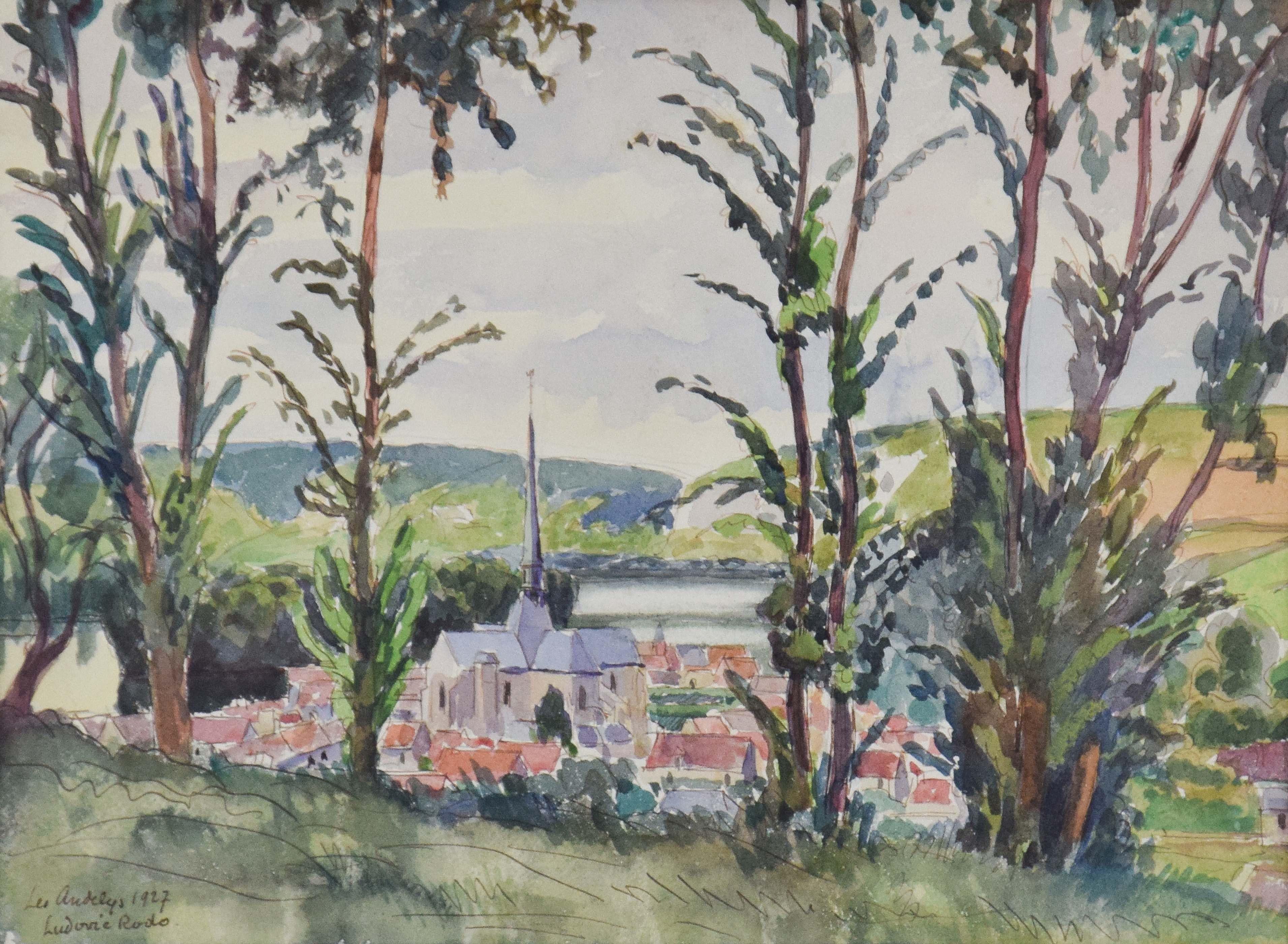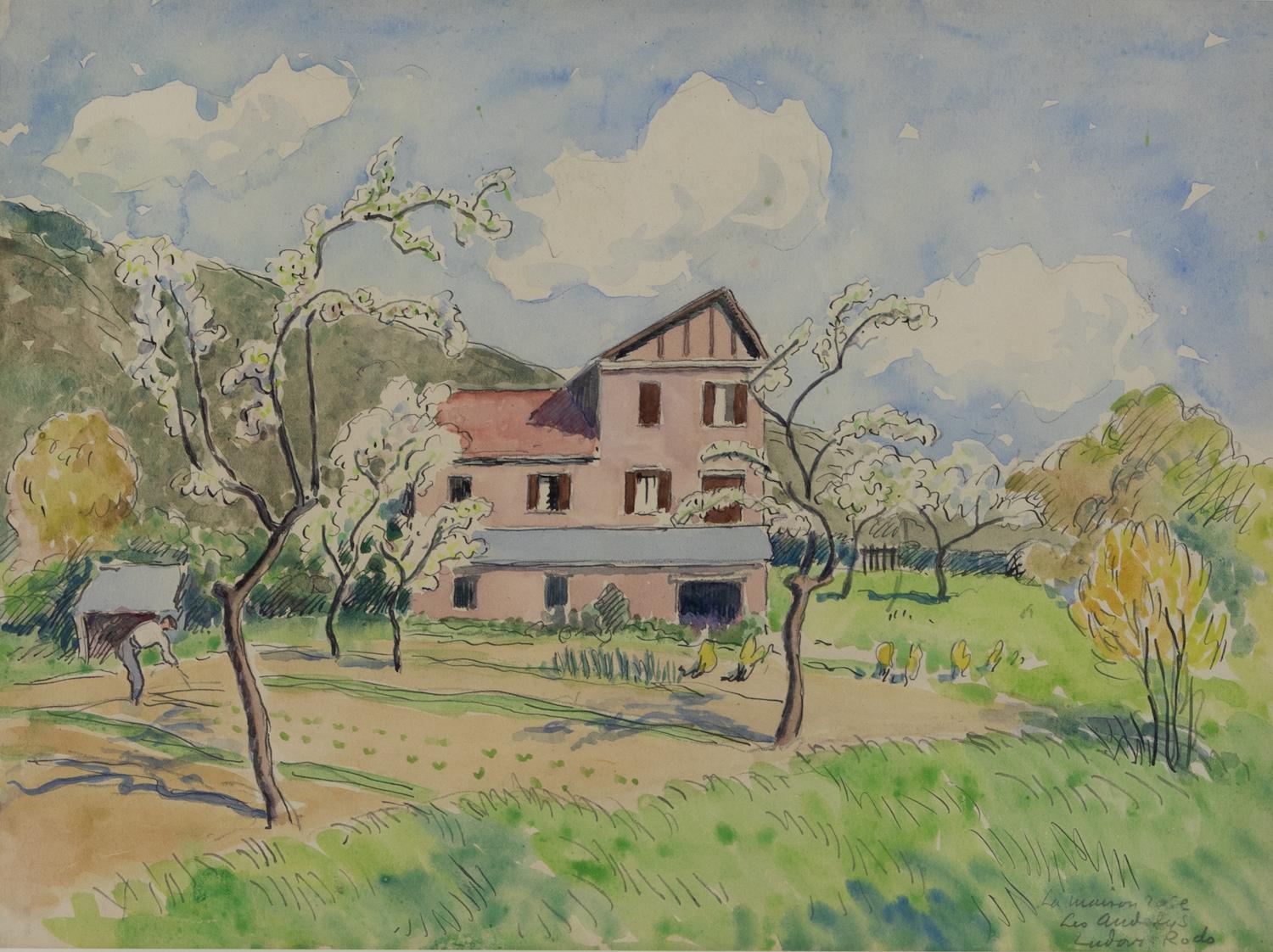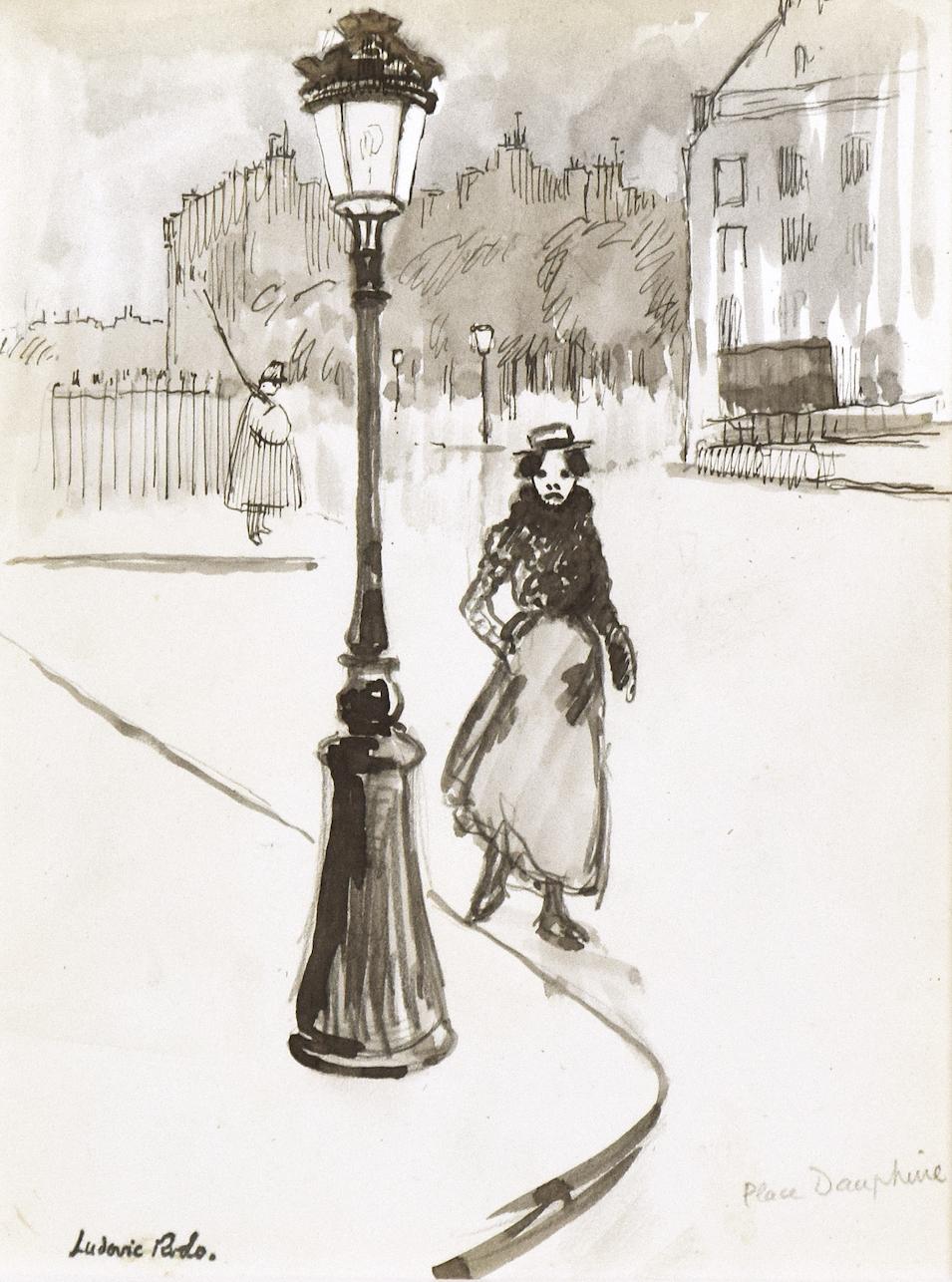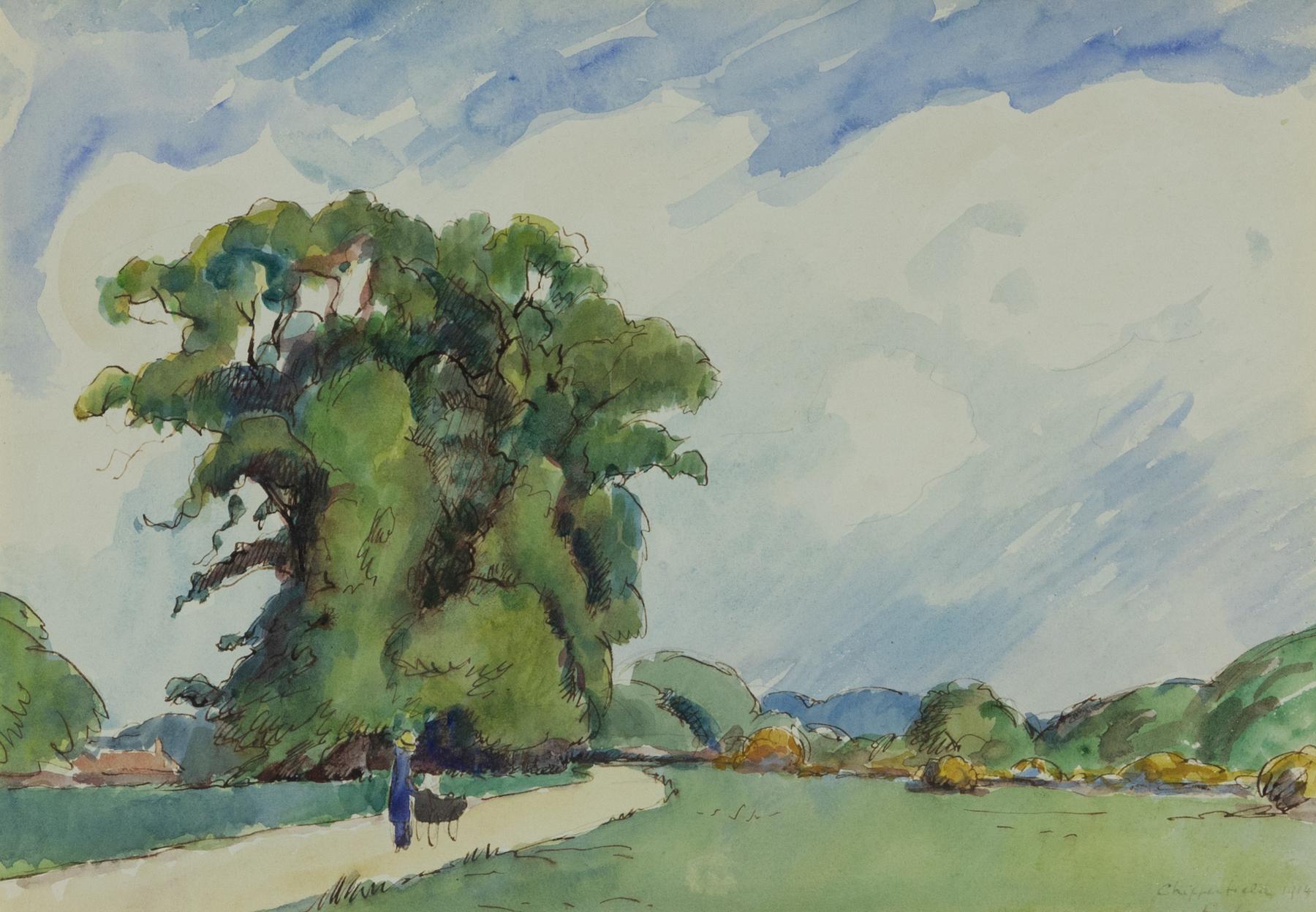Items Similar to L'Ile des Oiseaux by Paulémile Pissarro - Landscape watercolour
Want more images or videos?
Request additional images or videos from the seller
1 of 5
Paul Emile PissarroL'Ile des Oiseaux by Paulémile Pissarro - Landscape watercolour
About the Item
L'Ile des Oiseaux by Paulémile Pissarro (1884-1972)
Watercolour and charcoal on paper
23 x 31 cm (9 x 12 ¹/₄ inches)
Signed lower right, Paulémile Pissarro
Provenance
Private collection, UK
This work is accompanied by a certificate of authenticity from Lélia Pissarro.
Artist biography
Paulémile Pissarro, Camille Pissarro’s youngest son, was born in Éragny in 1884 where he was brought up within the creatively fertile environment of his family home and, encouraged by his father, began drawing at an early age. Paulémile’s godfather was Claude Monet, who became his teacher and legal guardian after Camille’s death in 1903.
In 1905 Paulémile exhibited at the Salon des Indépendants for the first time. Although his father had supported Paulémile’s desire to be an artist, his mother was eager for him to learn a more practical trade. Therefore in 1908 he put aside his artistic pursuits to work as an automobile mechanic and test-driver, then later as a lace and textile designer, allowing him only a limited time to paint. Paulémile only fully dedicated himself to painting following a letter from his brother Lucien in London, who wrote to invite him to take part in an exhibition held in London. Subsequent to the successful sale of a number of watercolours he had sent over, the young artist became inspired to leave the textile factory and pursue a career in art.
By the 1920s Paulémile had become an established Post-Impressionist artist in his own right, spending the summer months escaping from Paris on painting trips with fellow artists Kees Van Dongen, Raoul Dufy, Maurice de Vlaminck and André Dunoyer de Segonzac. In 1922 Paulémile purchased a house in Lyons-la-Forêt, a small village within the region of his hometown of Éragny and Giverny, where he moved in with his first wife Berthe Bennaiche. During this time, he developed a form of Cubism inspired by Paul Cézanne whom he dearly admired, creating some wonderful paintings of the river Eure and its surrounding villages. There he formed a close friendship with his neighbour, the famous Art Deco designer Émile-Jacques Ruhlmann, who designed a stunning Art Deco studio for Paulémile adjacent to his house.
In 1930 he visited and fell in love with the Swiss Normandy area in the Calvados region, in particular the River Orne which runs through the valley adjacent to the villages of Clécy and St. Remy. The combination of rolling hills, bold meadows and the calm river weaving its way through the landscape offered Paulémile a new burst of inspiration. With his second wife Yvonne Beaupel, Paulémile eventually moved to Clécy in 1935, where he would remain for the rest of his life. Of their three children, both H. Claude and Yvon also became artists.
With his house backing on to the river Orne, Paulémile developed a new way of working using a boat as a floating studio, where he spent countless days painting the calm waters from between the riverbanks. Here the influence of his godfather Claude Monet became apparent, particularly in Paulémile’s depiction of water, which was revolutionised by the Impressionist icon. He also applied Monet’s lessons in horticulture to the creation of an abundant garden, offering him many more motifs for his new paintings. Alongside these river landscapes, he also painted the neighbouring hay fields, various snow scenes, some interiors and still lives. The most ambitious work in his oeuvre was a fresco painted on all four walls of his own dining room, depicting the adjacent river in which he includes family members, neighbours and friends.
In 1967 Paulémile had his first one-man show in the United States at Wally Findlay Galleries in New York. This led to widespread recognition and a degree of professional success that few Pissarro artists knew during their lifetime. Since his death in 1972, Paulémile remains one of the best known of Camille’s sons.
- Creator:Paul Emile Pissarro (1884-1972, French)
- Dimensions:Height: 9.06 in (23 cm)Width: 12.21 in (31 cm)
- Medium:
- Movement & Style:
- Period:
- Condition:
- Gallery Location:London, GB
- Reference Number:1stDibs: LU261210501942
About the Seller
5.0
Recognized Seller
These prestigious sellers are industry leaders and represent the highest echelon for item quality and design.
Platinum Seller
These expertly vetted sellers are 1stDibs' most experienced sellers and are rated highest by our customers.
Established in 1964
1stDibs seller since 2015
95 sales on 1stDibs
Typical response time: 4 hours
Associations
Society Of London Art Dealers
- ShippingRetrieving quote...Ships From: London, United Kingdom
- Return PolicyA return for this item may be initiated within 7 days of delivery.
More From This SellerView All
- Les Andelys by Ludovic-Rodo Pissarro - Landscape watercolourBy Ludovic-Rodo PissarroLocated in London, GBLes Andelys by Ludovic-Rodo Pissarro (1878-1952) Watercolour and ink on paper 28 x 38 cm (11 x 15 inches) Inscribed, dated and signed lower left, Les Andel...Category
1920s Post-Impressionist Figurative Drawings and Watercolors
MaterialsPaper, Ink, Watercolor
- La Maison Rose, Les Andelys by Ludovic-Rodo Pissarro - Landscape, watercolourBy Ludovic-Rodo PissarroLocated in London, GB*UK BUYERS WILL PAY AN ADDITIONAL 20% VAT ON TOP OF THE ABOVE PRICE La Maison Rose, Les Andelys by Ludovic-Rodo Pissarro (1878-1952) Watercolour, ink and ...Category
1930s Post-Impressionist Figurative Drawings and Watercolors
MaterialsPaper, Ink, Watercolor, Pencil
- City View by Ludovic-Rodo Pissarro - Landscape paintingBy Ludovic-Rodo PissarroLocated in London, GBSOLD UNFRAMED City View by Ludovic-Rodo Pissarro (1878-1952) Watercolour and ink on paper 17.8 x 22.9 cm (7 x 9 inches) Signed with Estate stamp Executed circa 1904 Provenance Priv...Category
Early 1900s Fauvist Figurative Drawings and Watercolors
MaterialsPaper, Ink, Watercolor
- Place Dauphine by Ludovic-Rodo Pissarro - WatercolourBy Ludovic-Rodo PissarroLocated in London, GBPlace Dauphine by Ludovic-Rodo Pissarro (1878-1952) Watercolour and ink on paper 21 x 15.7 cm (8 ¼ x 6 ¼ inches) Signed with Estate stamp lower left Ins...Category
Early 1900s Post-Impressionist Figurative Drawings and Watercolors
MaterialsPaper, Ink, Watercolor
- Paysage à Chippenfield by Ludovic-Rodo Pissarro - Landscape watercolourBy Ludovic-Rodo PissarroLocated in London, GB*UK BUYERS WILL PAY AN ADDITIONAL 20% VAT ON TOP OF THE ABOVE PRICE Paysage à Chippenfield by Ludovic-Rodo Pissarro (1878-1952) Watercolour and ink on paper 23 x 33 cm (9 x 13 inche...Category
1910s Post-Impressionist Figurative Drawings and Watercolors
MaterialsPaper, Ink, Watercolor
- Grand Arbre dans la Sente by Ludovic-Rodo Pissarro - WatercolourBy Ludovic-Rodo PissarroLocated in London, GB*UK BUYERS WILL PAY AN ADDITIONAL 20% VAT ON TOP OF THE ABOVE PRICE Grand Arbre dans la Sente by Ludovic-Rodo Pissarro (1878-1952) Watercolour and ink on paper 28 x 38 cm (11 x 15 i...Category
1910s Fauvist Figurative Drawings and Watercolors
MaterialsWatercolor, Paper, Ink
You May Also Like
- Kelpie of Snooziepool - English Romantic Whimsical Fantasy Ink WatercolorBy William Heath RobinsonLocated in Miami, FLThe Kelpie of Snooziepool - William Heath Robinson illustrated this whimsical fantasy work featuring a semi-nude beauty in a pool of water with children. Based on the Metropolitan ...Category
1920s Post-Impressionist Figurative Drawings and Watercolors
MaterialsInk, Watercolor
- "Two Villages" - Black and White Ink Landscape Drawing By Joan Carl StraussLocated in Pasadena, CA"Two Villages" is a black and white landscape ink drawing by Joan Carl Strauss that unfolds a narrative of hidden rivalry within a picturesque valley. In the heart of a flat-floore...Category
1980s Post-Impressionist Landscape Drawings and Watercolors
MaterialsWatercolor, Ink
- "At The Longchamp Races", Gouache on paper by Spanish Artist Roberto DomingoBy Roberto Domingo FallolaLocated in Madrid, ESROBERTO DOMINGO FALLOLA Spanish, 1883 - 1956 AT THE LONGCHAMP RACES signed and located "R. Domingo, París" (upper right) gouache on paper 10-1/2 x 13-1/4 inches ( 26.5 x 33.4 cm.) f...Category
1940s Post-Impressionist Landscape Drawings and Watercolors
MaterialsPaper, Gouache
- Italian Village - Mid 20th Century Impressionist Watercolour by BennettBy Sterndale BennettLocated in Watford, HertfordshireSterndale Bennett Honor 1886-1975 Watercolour artist, born in Watford, she married into the famous family noted for its composers and for its military members. As an army wife she s...Category
1950s Post-Impressionist Landscape Drawings and Watercolors
MaterialsWatercolor, Paper
- South of France - Early 20th Century Impressionist Watercolour by BennettBy Sterndale BennettLocated in Watford, HertfordshireSterndale Bennett Honor 1886-1975 Watercolour artist, born in Watford, she married into the famous family noted for its composers and for its military members. As an army wife she s...Category
1920s Post-Impressionist Landscape Drawings and Watercolors
MaterialsWatercolor, Paper
- Concours de Chiens au Promenade by Otto EerelmanBy Otto EerelmanLocated in New Orleans, LAOtto Eerelman 1839-1926 Dutch Concours de Chiens au Promenade Watercolor on paper Signed “O. Eerelman 1904” (lower left) A tour de force watercolor by celebrated Dutch artist Otto Eerelman, one of 19th-century Europe's most popular and important animal portraitists, this charming composition captures a bustling cross-section of fashionable elites walking their equally fashionable canine companions. Eerleman takes care to render the detailed attire of his subjects, complete with plumed hats and layers of lace trim. The artist paints the plethora of pets in equally painstaking detail, capturing the nuances of each different breed represented. Eerelman mastered the art of depicting not only the dogs’ physical characteristics but also their unique expressions and personalities. His wealthy clientele would bring their pets to his home in The Hague where they would live for a period of time while having their portraits done, allowing for a remarkably true-to-life portrayal. This energetic watercolor, with its profusion of color and texture, harnesses the affluence of its subjects and the leisurely whimsy of their luxurious lives. Hailing from Groningen, Netherlands, Eerelman was dubbed the “Northern Rembrandt” during his lifetime. He received his artistic training at the Academy Minerva in Groningen, the Royal Academy of Fine Arts in Antwerp and then private lessons in the studio of the great Lawrence Alma Tadema. He successfully captured the attention of the Dutch court, particularly Princess Wilhelmina...Category
Early 20th Century Post-Impressionist Figurative Drawings and Watercolors
MaterialsPaper, Watercolor
Recently Viewed
View AllMore Ways To Browse
Watercolor Death
Watercolor Of Room
Impressionist Watercolor Paris
Fresco Paint
Iconic Desings
Watercolor Paintings Valleys
Sale On Watercolors
Watercolor 1967
Cezanne Paul
Small Ink And Watercolor
Watercolour Still Lives
Monet Drawings
Garden Design Watercolor
Small Impressionist Watercolors
Pissarro Camille
Watercolor Village Scene
Watercolor Cubism
Watercolor Landscape Snow





